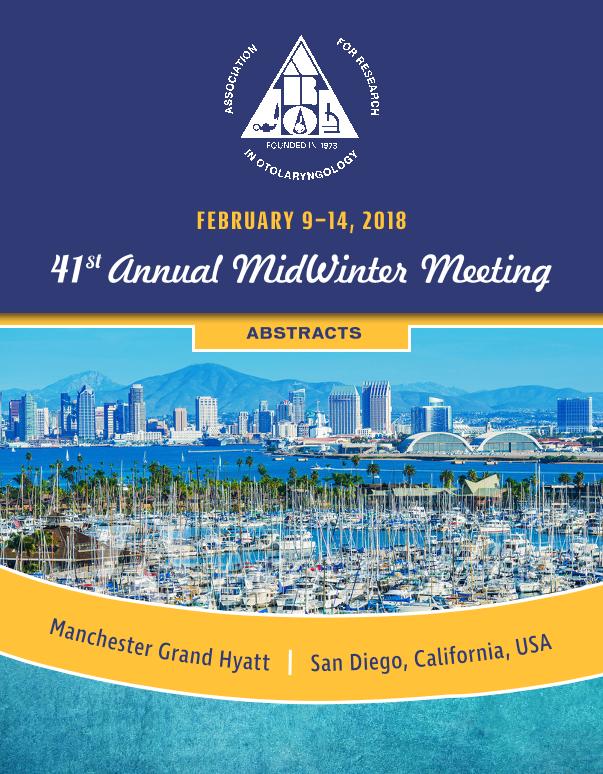Mostrar el registro sencillo del ítem
dc.contributor.author
Vattino, Lucas Gabriel

dc.contributor.author
Ballestero, Jimena Andrea

dc.contributor.author
Maison, Stéphane F.
dc.contributor.author
Di Guilmi, Mariano Nicolás

dc.contributor.author
Taranda, Julian

dc.contributor.author
Liberman, Charles M.
dc.contributor.author
Fuchs, Paul A.
dc.contributor.author
Katz, Eleonora

dc.contributor.author
Elgoyhen, Ana Belen

dc.date.available
2022-04-07T13:25:14Z
dc.date.issued
2018
dc.identifier.citation
Enhanced hair cell postsynaptic responses alter release from presynaptic efferent neurons to prolong inhibition of the cochlea; 41St Annual MidWinter Meeting; San Diego; Estados Unidos; 2018; 1-3
dc.identifier.issn
0742-3152
dc.identifier.uri
http://hdl.handle.net/11336/154581
dc.description.abstract
Gain control of the auditory system operates at multiple levels. Cholinergic medial olivocochlear (MOC) fibers that originate in the brainstem and make direct synaptic contacts at the base of the outer hair cells (OHCs) are the final targets of several feedback loops from both the periphery and higher processing cen ters. Efferent activation inhibits somatic electromotil ity of OHCs, an active amplification system within the mammalian cochlea. This is mediated by the activa tion of a calcium permeable α9α10 ionotropic cho linergic nicotinic receptor (nAChR) functionally cou pled to calcium activated SK potassium channels. The strength of cochlear inhibition is driven by the rate of MOC activity and short term facilitation at the MOC OHC synapse (Ballestero et al., 2011).The present work shows that a knockin mouse with a mutation in the α9α10 nAChR (L9’;T) with increased channel gating (Taranda et al., 2009) greatly prolongs hair cell evoked inhibitory postsynaptic currents (IPSCs). Long-term presynaptic compensatory mechanisms lead to reduced quantum content (IHC wt =1.29 ± 0.21; L9’;T= 0.83 ± 0.12, n=5- 6. OHC wt =0.23 ± 0.04, L9’;T = 0.14 ± 0.02, n=12-15). However, upon high frequency stimulation of MOC-OHC synapses, L9’;T mice exhibited more facilitation leading to greatly prolonged synaptic responses (S2 /S1- 40Hz: wt = 1.37 ± 0.16, L9’;T = 3.47 ± 0.44, n = 6-8, p< 0.05). At the cochlear physiology level, these synaptic changes were matched by a longer time course of efferent MOC suppression of DPOAEs. Thus, the maximal suppres sive effect of electrical shocks (70-s, 200 Hz) at the base of the IVth ventricle was doubled both at 16 (p < 0.01) and 22 kHz (p < 0.05), reached much more slowly (16 kHz: wt = 5.3 ± 1.0 s, L9’;T = 30.8 ± 4.1 s; 22 kHz: wt = 1.5 ± 0.4 s, L9’;T = 44.1 ± 3.1 s) and persisted for a longer time after the shocks for both 16 and 22 kHz in L9’;T mice (> 5 min) as compared to their wt littermates (≤1 s). These results indicate that the properties of the MOC-OHC synapse directly determine the efficacy of the MOC feedback to the cochlea being a main player in the “gain control” of the auditory periphery.
dc.format
application/pdf
dc.language.iso
eng
dc.publisher
Association for Research in Otolaryngology
dc.rights
info:eu-repo/semantics/openAccess
dc.rights.uri
https://creativecommons.org/licenses/by-nc-sa/2.5/ar/
dc.subject
SISTEMA EFERENTE OLIVOCOCLEAR
dc.subject.classification
Biología del Desarrollo

dc.subject.classification
Ciencias Biológicas

dc.subject.classification
CIENCIAS NATURALES Y EXACTAS

dc.title
Enhanced hair cell postsynaptic responses alter release from presynaptic efferent neurons to prolong inhibition of the cochlea
dc.type
info:eu-repo/semantics/publishedVersion
dc.type
info:eu-repo/semantics/conferenceObject
dc.type
info:ar-repo/semantics/documento de conferencia
dc.date.updated
2022-03-17T14:09:08Z
dc.journal.volume
41
dc.journal.pagination
1-3
dc.journal.pais
Estados Unidos

dc.journal.ciudad
Brentwood
dc.description.fil
Fil: Vattino, Lucas Gabriel. Consejo Nacional de Investigaciones Científicas y Técnicas. Instituto de Investigaciones en Ingeniería Genética y Biología Molecular "Dr. Héctor N. Torres"; Argentina
dc.description.fil
Fil: Ballestero, Jimena Andrea. Consejo Nacional de Investigaciones Científicas y Técnicas. Instituto de Investigaciones en Ingeniería Genética y Biología Molecular "Dr. Héctor N. Torres"; Argentina
dc.description.fil
Fil: Maison, Stéphane F.. Harvard Medical School; Estados Unidos
dc.description.fil
Fil: Di Guilmi, Mariano Nicolás. Consejo Nacional de Investigaciones Científicas y Técnicas. Instituto de Investigaciones en Ingeniería Genética y Biología Molecular "Dr. Héctor N. Torres"; Argentina
dc.description.fil
Fil: Taranda, Julian. Consejo Nacional de Investigaciones Científicas y Técnicas. Instituto de Investigaciones en Ingeniería Genética y Biología Molecular "Dr. Héctor N. Torres"; Argentina
dc.description.fil
Fil: Liberman, Charles M.. Harvard Medical School; Estados Unidos
dc.description.fil
Fil: Fuchs, Paul A.. University Johns Hopkins; Estados Unidos
dc.description.fil
Fil: Katz, Eleonora. Consejo Nacional de Investigaciones Científicas y Técnicas. Instituto de Investigaciones en Ingeniería Genética y Biología Molecular "Dr. Héctor N. Torres"; Argentina. Universidad de Buenos Aires. Facultad de Ciencias Exactas y Naturales; Argentina
dc.description.fil
Fil: Elgoyhen, Ana Belen. Consejo Nacional de Investigaciones Científicas y Técnicas. Instituto de Investigaciones en Ingeniería Genética y Biología Molecular "Dr. Héctor N. Torres"; Argentina. Universidad de Buenos Aires. Facultad de Medicina. Instituto de Farmacología; Argentina
dc.relation.alternativeid
info:eu-repo/semantics/altIdentifier/url/https://aro.org/wp-content/uploads/2020/09/2018_ARO_Abstracts_ALL_PAGES.pdf
dc.conicet.rol
Autor

dc.coverage
Internacional
dc.type.subtype
Reunión
dc.description.nombreEvento
41St Annual MidWinter Meeting
dc.date.evento
2018-02-09
dc.description.ciudadEvento
San Diego
dc.description.paisEvento
Estados Unidos

dc.type.publicacion
Journal
dc.description.institucionOrganizadora
Association for Research in Otolaryngology
dc.source.revista
41St Annual MidWinter Meeting: Abstracts
dc.date.eventoHasta
2018-02-14
dc.type
Reunión
Archivos asociados
